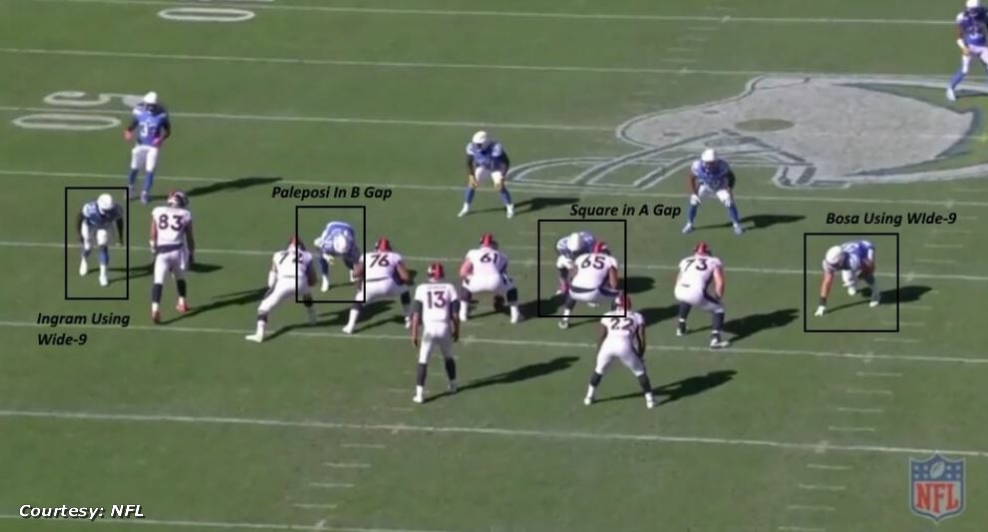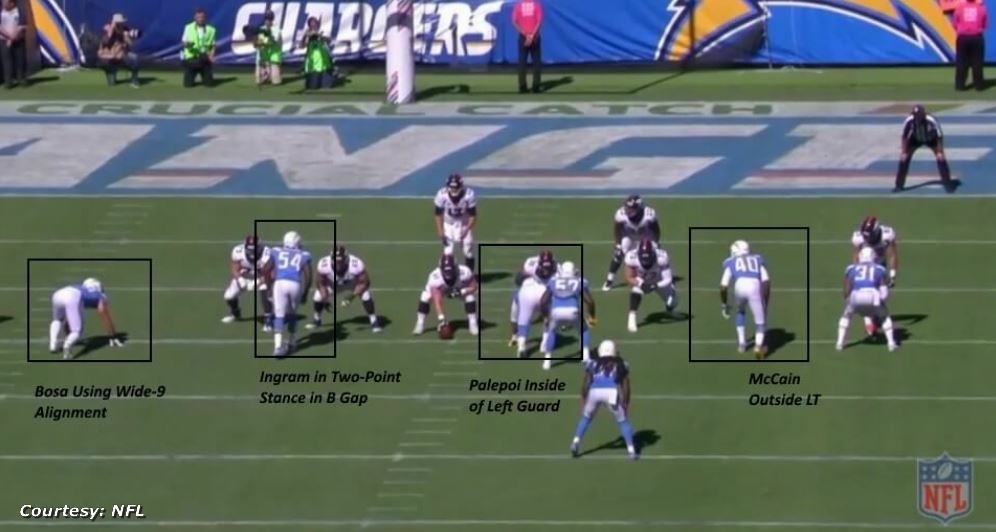X vs. O: Breaking down Week 1's most intriguing on-field matchups
Welcome to the first scheme preview piece of the 2018 season.
Each week, we'll examine three schematic questions that should go a long way toward determining the outcome of contests in the upcoming weekend. The following week, we'll examine how these questions were answered (if they were) while also looking at some other cool concepts and designs that teams used on the ground, in the air, and even on defense to secure wins.
So, let’s dive into three of Week 1's most notable matchups:
Patriots' D vs. Deshaun Watson
The recent editions of the New England Patriots have struggled mightily when facing mobile quarterbacks.
Aaron Rodgers, Alex Smith, Russell Wilson, and Deshaun Watson have averaged 30.1 points in their previous eight games against New England. In those games, the quartet combined to complete over 65 percent of their passes for an average of 302 yards per game, 9.1 yards per passing attempt, and 2.5 touchdown passes per contest. Their combined passer rating was 115.1, and they averaged less than an interception per game.
Watson, whom the Patriots are tasked with defending in their season opener against the Houston Texans, went 22 of 33 for 301 yards with two touchdowns and two interceptions at Foxboro as a rookie in Week 3 last season - good for a quarterback rating of 90.6. He also chipped in 41 rushing yards on eight carries, and only a last-second touchdown drive by Tom Brady prevented the Texans from pulling off the upset.
Here's an example from Watson's game in New England that illustrates what makes a mobile quarterback so difficult to defend - in this case using a zone coverage:
On the play, New England deploys a Cover 3 in the secondary and - as Watson breaks the pocket - the defenders lose track of tight end Ryan Griffin, who's all alone on the right sideline. Watson finds his tight end, and the Texans have a huge gain.
This poses a dilemma for defenses facing quarterbacks like Watson. They can rely on the guys in the back half to play man coverage and stay on their receivers deep into plays, but that choice can result in the quarterback taking off to run while defenders have their backs turned. And as we just saw, zone coverages make it easier for receivers to find open space when plays break down and the quarterback moves around.
Up front, a defense could employ more of a "mush rush," with the goal not being to get to the quarterback, but to keep him contained in the pocket. But in doing so, just one slip-up can result in the quarterback breaking free and taking off. This is why teams often employ a “spy” - a linebacker dedicated to shadowing the quarterback on any given play. This is something the Patriots utilized at times in the playoffs last year, with Marquis Flowers spying Marcus Mariota. However, Flowers is no longer a Patriot, so a player such as Kyle Van Noy or rookie linebacker Ja'Whaun Bentley might be asked to serve in this role.
However the Patriots decide to approach their matchup with Watson, it's an important question for the team to answer this Sunday. And given they'll face a bunch of mobile pivots this season - including Blake Bortles, Mariota, Rodgers, Andrew Luck, and Patrick Mahomes - it's a question the Patriots will face often throughout 2018.
Vikings' LBs vs. 49ers' RBs in passing game
This showdown is a prime example of strength versus strength.
We've previously outlined how successful San Francisco 49ers coach Kyle Shanahan is at designing passing plays using multiple running backs in the formation. These designs force the defense to stay in its base personnel package, which sets up favorable matchups for the running backs against linebackers. With the loss of Jerick McKinnon to a season-ending knee injury, the 49ers might not have the matchup advantage they were hoping for this season, but others like Matt Breida, Alfred Morris, and even fullback Kyle Juszczyk are potential weapons for Shanahan in the passing game.
Here's an example of Shanahan scheming Juszczyk open:
However, the Minnesota Vikings' defense - which will face San Francisco in Week 1 - was the league's stingiest when it came to covering running backs in the passing game in 2017, allowing just 77 completions for a mere 494 yards (second lowest in the league) and just one touchdown (fewest in the league). That disciplined coverage is illustrated in the play below, which shows why it was so tough for opponents to throw to running backs against Minnesota:
In the example, the Carolina Panthers try to set up a quick slip screen to running back Christian McCaffrey. You can see just how fast this Vikings’ defense is, led by linebacker Anthony Barr (No. 55), who sniffs out the play immediately before help arrives. The quickness of this defense might be too much for the two-back passing attack of the 49ers, but you can be sure Shanahan has some surprises up his sleeve.
Patrick Mahomes vs. Chargers' D-line
Finally, we turn to young Patrick Mahomes as he embarks on his first season as the full-time starting quarterback for the Kansas City Chiefs. In his lone start last year, a Week 17 outing against the Denver Broncos, Mahomes flashed the arm talent and the audaciousness that make him such an intriguing young prospect. Cut from a true gunslinger cloth, there's no coverage or throwing window that scares Mahomes.
What might give Mahomes pause, however, is how his Week 1 opponent, the Los Angeles Chargers, look to attack opposing passers with pressure up front. The Chargers can apply that pressure with their base defensive front - relying on premier talents at the edge position like Joey Bosa - and they've also been known to utilize a more speed-rushing package, particularly on passing downs. Both approaches have the potential to give Mahomes a headache.
Here's a look at what the Chargers can do in their base defensive front. They often rely on the "wide-9" alignment, which puts the defensive ends well outside of the offensive tackles:

This essentially puts the tackles on an island, away from the rest of the offensive line and their potential help on the inside. The defenders can then use a variety of pass-rushing moves or just pure quickness and speed to beat the offensive tackles in one-on-one matchups:
Meanwhile, the more speed-rushing package was implemented in 2017, which uses an extra defensive end up front and tries to isolate that defender on an interior offensive lineman while keeping Melvin Ingram and Bosa on the field. Players like Chris McCain and Jeremiah Attaochu helped with this approach and gave the Chargers a look like this up front:

Here against the Broncos, Ingram aligns inside, working against the right guard while Bosa and McCain are on the edges. Ingram, matched up against a less athletic offensive guard, is able to put a move on his man and get to the quarterback:
The Chargers used a similar package at times during the 2018 preseason, even though Bosa was sidelined with an injury. On this third-and-8 play against the Arizona Cardinals in Week 1 of the preseason, they lined up with three edge-type players on the field up front:

Here, the Chargers have Uchenna Nwosu on one edge in the wide-9 alignment outside the left tackle and Chris Landrum on the other. Darius Philon aligns across from the left tackle, while Bosa’s backup, Isaac Rochell, kicks inside and lines up across from the right guard. Watch the pressure they apply to rookie quarterback Josh Rosen:
With Bosa returning to practice this week and expected to go on Sunday, you can anticipate the Chargers will use both him and Ingram on looks like this, with perhaps Rochell remaining on the field to work against interior offensive linemen in the speed-rushing package.
So, how can Mahomes counter these pass-rushing packages? By getting the ball out of his hands quickly.
Look for Andy Reid to implement a lot of quick throws and designed screens to force the Chargers' defense to play sideline to sideline. Of course, when you have a quarterback who moves in the pocket like this (while keeping his eyes downfield), that helps too:
If Mahomes can handle the Chargers’ pressure schemes like this, the Chiefs might be set for a big day.
Mark Schofield write NFL feature content for theScore. After nearly a decade of practicing law in the Washington, D.C. area Mark changed careers and started writing about football. Drawing upon over a decade of playing quarterback, including at the collegiate level, Mark focuses his work on quarterback evaluation and offensive scheme analysis. He lives in Maryland with his wife and two children. Find him on Twitter @MarkSchofield.